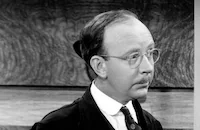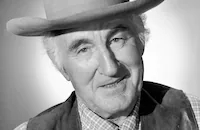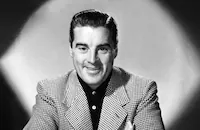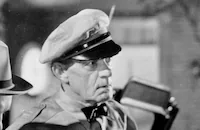The Key

Brief Synopsis
Cast & Crew
Michael Curtiz
William Powell
Edna Best
Colin Clive
Hobart Cavanaugh
Halliwell Hobbs
Film Details
Technical Specs

Synopsis
In 1920, in response to Irish demands for home rule, the British impose martial law on their neighboring nation. Andrew Kerr is a member of the "Black and Tans," a British army unit sent to maintain order in Ireland. He is troubled by his position, as his mother was Irish, but his wife Norah consoles him, saying that this is politics, not war. Bill Tennant, an old army friend of Andrew, is sent to Dublin and rents the flat below the Kerrs's. When Andrew invites him up for tea, Bill realizes that Norah is a woman he was in love with years before but left because he did not want to be tied down. Upset by his meeting with Norah, Bill has a drink in a pub. When he spots Bill's uniform underneath his overcoat, O'Duffy, a go-between, gives him a password to use if he should ever want to help the Irish. That evening, Andrew is assigned to search the dock area for Peadar Conlan, one of the Irish leaders, who is a fugitive from justice. Norah begs him not to leave, but he cannot shirk his duty. While he is gone, Bill and Norah rekindle their romance. When Andrew returns after capturing Conlan, he finds them together, at which point Norah tells him that she knew Bill before and still loves him. Andrew runs out into the streets, where he is recognized as the man who captured Conlan and is held hostage for Conlan's release. Norah, having realized that she really loves Andrew, tells Bill that he is a romantic dreamer. When the British refuse to trade Andrew for Conlan, Bill uses the password O'Duffy gave him to negotiate for Andrew's freedom. He forges a release for Conlan. Bill is arrested, but he has reunited Norah and Andrew.

Director

Michael Curtiz
Cast

William Powell

Edna Best

Colin Clive

Hobart Cavanaugh

Halliwell Hobbs

Donald Crisp

J. M. Kerrigan

Henry O'neill

Phil Regan

Arthur Treacher
Maxine Doyle
Arthur Aylesworth
Gertrude Short

Dawn O'day

Lew Kelly
Dixie Loftin
Olaf Hytten
David Thursby
Robert Homans
Desmond Roberts
John Elliott
James May
Douglas Gordon

Mary Mclaren
Pat Somerset
Wyndham Standing
Ralph Remley
Aggie Herring
Katherine Clare Ward

Charles Irwin
Lowin Cross
Edward Cooper
Luke Cosgrove
Crew
Mort Dixon
Laird Doyle
John Ellis
Leo F. Forbstein
Martin Glouner
Robert M. Haas
Ernest Haller
Dr. Thomas Maclaughlin
Frank Mcdonald
Tom More
Orry-kelly
Robert Presnell
Thomas Richards
Al Roberts
Dudley Slausson
Roy Thompson
Allie Wrubel

Videos
Movie Clip



Trailer
Film Details
Technical Specs

Articles
The Key (1934)
It's not as though he was unqualified for movie fame. Unlike other actors like Clara Bow or Emil Jannings, whose careers foundered in the sound era, Powell blossomed once the audience could hear his voice -- his clear, theatrical baritone could inject a roguish wink into the most unremarkable lines. He was tall and good looking, in a mature, sleepy-eyed way, and his unforced charisma had the knack of commanding the audience's attention, whether he was playing the villain or the leading man. Nevertheless, Warner Brothers didn't know what to do with him, plunking him down in unsuitable projects like Fashions of 1934 (1934). Publicly, Powell didn't complain - he summed up his professional ethic by declaring "I do not hold that because the author did a bad job of writing the player need trump it with the same kind of acting" - but privately he seethed. His frustration was evident in the letter he wrote to Warner Brothers reminding them of the upcoming termination of his contract "which calls for my appearance in not more than four pictures or productions, one of which may, at my option, be made by a reputable producer other than your company . . .[Y]ou are hereby further notified it is my desire that one of my stipulated four productions shall be made by another producer."
Warner Brothers gave Powell his choice of final project - another Philo Vance mystery The Dragon Murder Case, an unproduced script entitled Dollar Wise, or an adaptation of the British play The Key. The Irish independence subject matter piqued Powell's interest, and he signed on to be directed again by Michael Curtiz, Warner Brothers' jack-of-all-trades director (most famous for Casablanca, 1942) who had already worked with Powell twice previously in Private Detective 62 and The Kennel Murder Case (both 1933). The Key tells the story of a "Black and Tan" officer (Powell) recruited to quell unrest in Dublin, only to discover his lost love (London stage veteran Edna Best) is now married to his friend, a fellow British Intelligence agent (Colin Clive, an English character actor most famous for exhorting "It's alive!" in Frankenstein [1931]).
Powell makes full use of all his gifts in The Key, right from the introductory scene where he flirts with a flower girl (a young Anne Shirley, billed here as "Dawn O'Day"), buys a blossom from her, and later puckishly hands it to his commanding officer. He's jaunty and charming in his trench coat uniform, suave without losing his sense of humor, and he gets all the best lines: lamenting about how he landed in a spot of "husband trouble" in Cairo, he muses how the husband involved "was a bit of a cad. If he'd been a gentleman he would have knocked." (The Key was shot in early 1934, scant months before the newly emboldened Hays Office insisted all motion pictures must earn an MPDDA seal certifying compliance with the Production Code before being released. Luckily, that suggestive line, and an adjoining subplot about an extramarital affair, remains in the final print.)
Powell fulfilled his contractual obligation with Warner Brothers and moved on to MGM to shoot Manhattan Melodrama (1934), his first pairing with Myrna Loy. Powell and Loy's chemistry was so sizzling MGM quickly placed the duo as the crime-solving sophisticates Nick and Nora Charles in The Thin Man (1934), an unqualified hit that marked the start of six Thin Man films and a total of fourteen features starring the duo, a partnership that's the cornerstone of Powell's legacy today. Warner Brothers realized that their former star had become a hot property. They shelved The Key for release after Manhattan Melodrama had hit theaters, hoping their movie could get a tailwind boost from Powell's ascent. Their strategy didn't quite work - The Key got mixed reviews and made only a minor profit. Meanwhile, Powell was nominated for Best Actor for his role in The Thin Man, leaving his former studio in the dust.
Producer: Robert Presnell, Sr. (uncredited)
Director: Michael Curtiz
Screenplay: Laird Doyle, R. Gore-Browne, J.L. Hardy (play)
Cinematography: Ernest Haller
Art Direction: Robert M. Haas
Film Editing: Thomas Richards
Cast: William Powell (Capt. Bill Tennant), Edna Best (Norah Kerr), Colin Clive (Capt. Andrew 'Andy' Kerr), Hobart Cavanaugh (Homer, Tennant's Aide), Halliwell Hobbes (General C.O. Furlong), Donald Crisp (Peadar Conlan), J.M. Kerrigan (O'Duffy), Henry O'Neill (Dan), Phil Regan (Young Irishman Killed by Andrew), Arthur Treacher (Lt. Merriman, Furlong's Aide)
BW-72m.
by Violet LeVoit
References:
Bryant, Roger. William Powell: The Life And Films. McFarland & Company, 2006
Francisco, Charles. Gentleman: The William Powell Story. St. Martins, 1985
Quirk, Lawrence J. The Complete Films Of William Powell. Citadel, 1986
Robertson, Dr. James C. The Casablanca Man: The Cinema of Michael Curtiz. Routledge, 1993

The Key (1934)
Quotes
Trivia
Notes
The pre-release title of the film was Sue of Fury. According to modern sources, the picture was retitled High Peril in the late 1950s to avoid confusion with the 1958 British film called The Key, starring William Holden and Sophia Loren. Michael Curtiz replaced Archie Mayo when he became ill with a stomach ailment. Although modern sources indicate that Phil Regan does not appear in the film, even though he is included in the onscreen credits, he actually does appear briefly in the sequence in which "Andrew" captures "Conlan." Regan appears as the man in a cap who shoots at "Andrew" but is killed by him.















